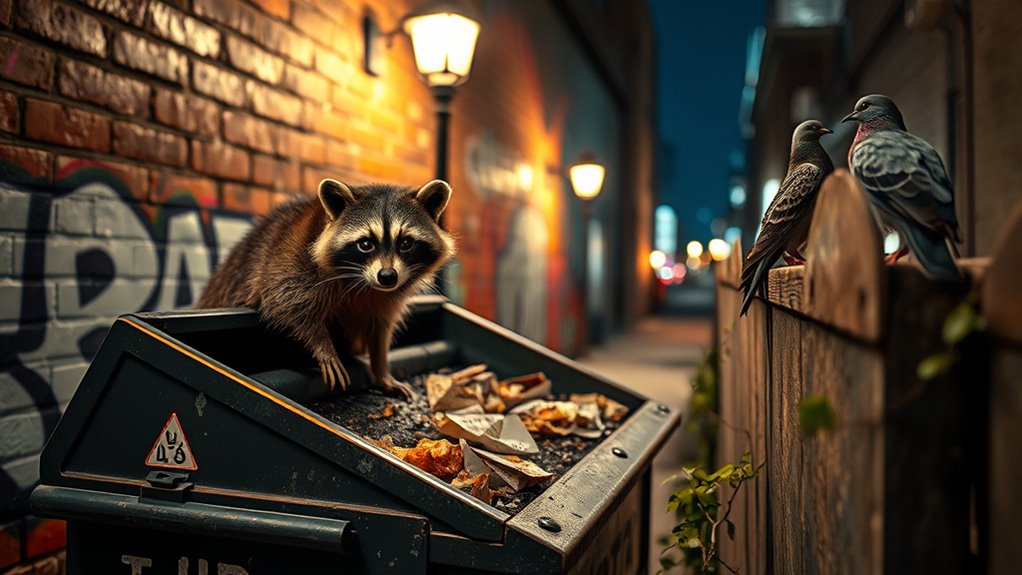Urban wildlife thrives in surprising corners of the city, adapting to bustling human life while creating rich ecosystems. From parks to vacant lots, diverse habitats shelter everything from birds to raccoons, as they scavenge for human food sources. These animals develop innovative strategies to survive, like adjusting their foraging patterns and becoming more active at night. However, challenges like pollution and habitat loss persist. Stay curious, and discover just how these creatures navigate their urban environments.
Key Takeaways
- Urban wildlife thrives in diverse habitats, utilizing parks, gardens, and vacant lots for food and shelter.
- Many species adapt their behaviors, such as scavenging human food sources and altering their activity patterns to avoid humans.
- Urban environments often lead to human-wildlife conflicts, including property damage and vehicle collisions, necessitating public awareness and coexistence strategies.
- Microhabitats play a crucial role in enhancing urban biodiversity by providing unique environments for shelter and breeding.
- Community involvement in conservation efforts and sustainable urban planning is essential for preserving wildlife habitats amidst urban development.
Diverse Habitats: A Home for Many

While urban development often brings challenges, it also creates a unique mosaic of habitats that support a surprising diversity of wildlife.
Urban development, despite its challenges, fosters diverse wildlife habitats, creating vibrant ecosystems within our cities.
In cities, you'll find parks, gardens, and vacant lots that provide food and shelter for various species. Suburban environments, with their gardens and ornamental plants, attract birds and mammals like deer and coyotes. Urban habitats are crucial for species like pigeons and starlings, which thrive in these settings. Additionally, the presence of educational toys in urban environments can foster a deeper appreciation for nature among children, encouraging them to engage with local wildlife.
Novel niches such as green roofs and constructed wetlands offer essential habitats for native biodiversity. Even industrial areas can serve as unexpected microhabitats.
Urban lakes and ponds become vital for aquatic species, enhancing overall biodiversity. By intentionally designing these spaces, you can help bolster wildlife populations, ensuring that urban areas remain vibrant ecosystems teeming with life.
Adapting to Urban Life: Survival Strategies

Urban wildlife has shown remarkable adaptability in response to the diverse habitats cities offer. You might notice that these animals cleverly exploit human food sources, from garbage to pet bowls. They use urban green spaces and gardens as essential nutrition sources, all while avoiding human disturbances. Additionally, many species engage in migration strategies to escape harsher winter climates, showcasing their resilience and adaptability.
| Adaptation Type | Examples | Benefits |
|---|---|---|
| Food Acquisition | Scavenging, using bird feeders | Access to diverse foods |
| Behavioral Adaptations | Urban corridors, altered activity | maneuvering human spaces |
| Physiological Adaptations | Hibernation, thicker coats | Energy conservation |
These strategies enable wildlife to thrive amid concrete jungles, proving that adaptability is key to survival in an ever-changing urban landscape.
The Role of Microhabitats in Urban Ecosystems

Microhabitats play an essential role in supporting urban ecosystems, offering unique environments that foster a diversity of species. These small, distinct habitats, such as moss-covered walls and tree cavities, provide essential resources for urban wildlife.
Here are three key benefits of urban microhabitats:
- Biodiversity Support: They offer shelter, food, and breeding grounds for various species, enhancing urban biodiversity.
- Pollution Mitigation: Microhabitats like urban ponds filter pollutants, improving water quality and supporting aquatic life. Urban water bodies often rely on these microhabitats to maintain healthier ecosystems.
- Ecosystem Resilience: By maintaining ecosystem services, microhabitats help cities adapt to environmental changes and foster resilience against climate impacts.
Despite facing challenges like pollution and fragmentation, conserving these microhabitats is vital for sustaining urban wildlife and overall ecosystem health.
Birds of the City: Common Avian Species

Cities are teeming with life, and among the most visible residents are birds. You'll likely spot the common starling, known for its large roosts that can lead to health hazards. Sociable birds that roost in large flocks, starlings prefer warmer city environments during winter.
The house sparrow, once drawn to horse-drawn transport, now struggles due to modern changes. Rock pigeons, descendants of domestic birds, thrive on urban food sources, while barn swallows often nest near buildings and bridges. Interestingly, some urban birds, like the frozen yogurt pops, have adapted to seek out human-made sources of food, enhancing their survival in cities.
Surprisingly, cities host around 20% of the world's bird species, showcasing impressive biodiversity. These adaptable creatures exploit available food and nesting sites, using urban structures like cliffs.
However, they face challenges, including pollution and habitat disruption. Supporting urban bird populations starts with creating green spaces and native vegetation to foster their survival.
Feral Animals: The Urban Wild

While exploring the bustling streets, you might encounter a variety of feral animals that have ingeniously adapted to urban life.
These creatures thrive in cities, often thanks to ample food sources and few natural predators. However, their presence can lead to significant wildlife mortality as they compete with native species and disrupt local ecosystems.
Here are three common feral animals you may spot:
- Domestic Cats: Often found in alleys and parks, they hunt small birds and rodents.
- Feral Dogs: These social animals form packs, scavenging for food and posing potential conflicts with humans.
- Canada Geese: Frequently seen in parks, they can disrupt local ecosystems by competing with native species.
Though feral animals add diversity to urban wildlife, they also challenge conservation efforts by competing with native species and causing human-wildlife conflicts.
Predators in the Concrete Jungle
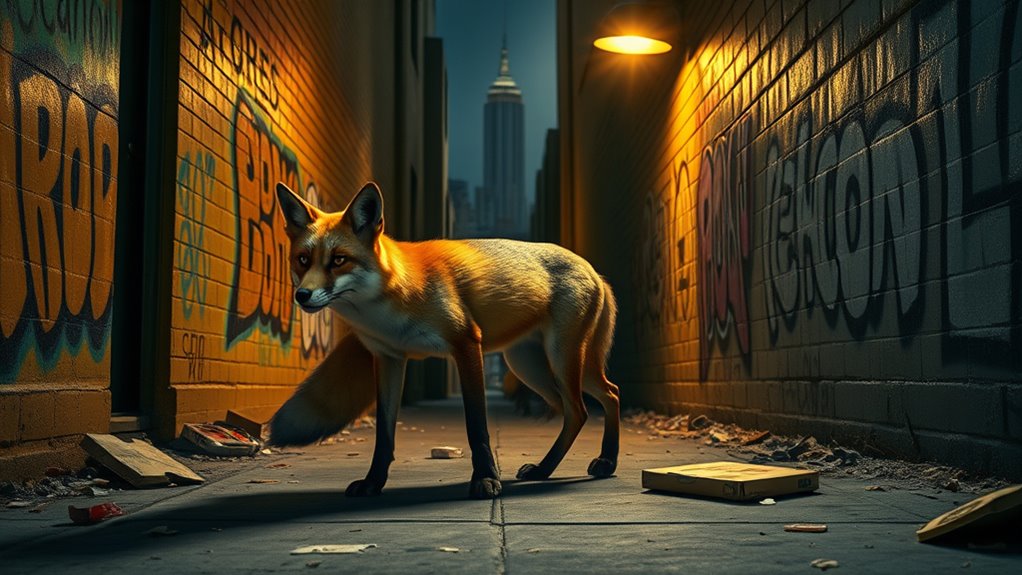
In the concrete jungle, you'll find a surprising array of predators adapting to urban life. As these animals navigate their new environment, prey availability plays a vital role in their survival. Urban areas often have concentrated and predictable food resources for predators, which is crucial for their success in these habitats urban environments can sustain high prey populations. Understanding how they interact with humans can help us coexist with these fascinating urban hunters.
Urban Predator Adaptations
As urban landscapes expand, coyotes and bobcats have adapted remarkably to thrive in these concrete jungles.
These predators showcase incredible flexibility in behavior and physiology, allowing them to coexist with humans while maintaining their ecological roles.
Here are three key adaptations:
- Diet Flexibility: Coyotes exploit diverse food sources, including waste and small mammals, adapting to urban environments.
- Nocturnal Activity: By being active at night, these predators avoid peak human interactions and extreme temperatures.
- Social Intelligence: Coyotes demonstrate problem-solving skills, enabling them to navigate urban challenges and maintain social structures. Additionally, their adaptability reflects the genetic changes seen in urban wildlife as they respond to the unique pressures of city life.
These adaptations not only help them survive but also play a vital role in regulating urban ecosystems, ensuring balance amid human encroachment.
Prey Availability Dynamics
Urban predators like coyotes and bobcats thrive thanks to their adaptability, but their success heavily relies on the availability of prey in these modified environments.
In urban areas, you'll notice that prey abundance varies, influencing predator activity and community dynamics. Insects and spiders serve as vital food sources for many urban birds, while species like pigeons and sparrows become common targets for hawks. Urban bird diversity is linked to the abundance of these prey species, highlighting the intricate balance of urban ecosystems.
As urbanization progresses, habitat features like tree canopy cover and impervious surfaces play pivotal roles in shaping these interactions.
Understanding these prey availability dynamics is essential for managing urban wildlife effectively. By maintaining robust prey populations, you can help support a diverse and balanced urban ecosystem, ultimately benefiting both predators and their prey.
Human-Wildlife Interactions
While many people enjoy the sight of wildlife from a distance, the reality of sharing space with urban predators can be unsettling. As cities expand, encounters with predators like coyotes and hawks are becoming more common.
Here are three key aspects of human-wildlife interactions:
- Adaptability: Urban predators thrive by exploiting diverse food sources, including garbage and small mammals, showcasing their remarkable adaptability.
- Conflict: Increased urban expansion often leads to conflicts, resulting in property damage and animal-vehicle collisions that can endanger both wildlife and humans.
- Coexistence Strategies: Cities are implementing public awareness campaigns and habitat modifications to promote peaceful coexistence, encouraging residents to understand and respect their urban wildlife neighbors. Proper management of urban green spaces can also help reduce potential conflicts by providing designated habitats for wildlife.
Challenges Faced by Urban Wildlife

Urban wildlife faces significant challenges as they navigate the complexities of city life. Conflicts with humans often arise from competition for resources, while environmental hazards like pollution and habitat loss threaten their survival. Understanding these issues is essential for fostering coexistence and protecting urban ecosystems. Research indicates that gentrified neighborhoods support one to two more species on average, highlighting the impact of urban development on wildlife diversity.
Human-Wildlife Conflicts
As human populations expand and encroach on natural habitats, conflicts between people and wildlife have become increasingly common in urban areas. These conflicts often lead to negative outcomes, such as property damage and threats to both human and wildlife safety. Here are three major types of human-wildlife conflicts you might encounter:
- Wildlife-vehicle collisions: These incidents can cause severe injuries or fatalities for both animals and humans.
- Property damage: Animals can destroy crops or invade homes, leading to economic losses.
- Physical attacks: Encounters with wildlife can result in attacks on humans or pets, raising safety concerns. Urban wildlife often face challenges as they adapt to fragmented habitats within cities.
Understanding these conflicts is essential for finding effective solutions that promote coexistence and safeguard urban wildlife.
Environmental Hazards
Conflicts with wildlife often stem from the challenges urban environments present, impacting the survival of various species. Habitat loss and fragmentation limit space for wildlife, making it hard for them to thrive. Pollution from chemicals and plastics contaminates water and soil, harming ecosystems. Urban heat islands and extreme weather events add stress, forcing species to adapt quickly or perish. Invasive species outcompete native wildlife, leading to decreased biodiversity. Additionally, infrastructure creates barriers that hinder movement and migration, isolating populations. Vehicle collisions and building strikes further threaten urban wildlife. As cities expand, green spaces dwindle, leaving animals with fewer places to live and thrive. Addressing these hazards is critical for sustaining urban wildlife populations, especially in areas like Baltimore, where urban biodiversity plays a vital role in the ecosystem.
Innovative Adaptation Strategies
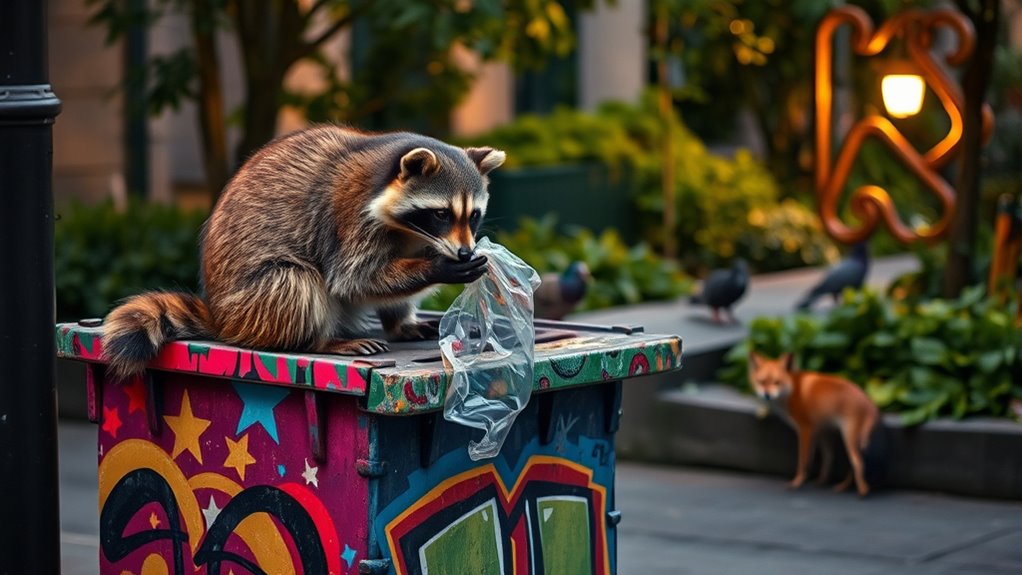
While cities continue to expand, innovative adaptation strategies are essential for helping urban wildlife thrive in increasingly fragmented habitats. You can help support these initiatives in your community, ensuring a harmonious coexistence with nature. Here are three effective strategies:
- Creating Wildlife Corridors: Establish pathways that allow animals to safely navigate between habitats, such as green strips or bridges over highways.
- Native Plant Landscaping: Use local plants that provide food and shelter for wildlife while reducing maintenance needs and water usage. Promoting urban biodiversity is crucial for enhancing resilience to environmental changes.
- Green Infrastructure: Incorporate features like green roofs and parks that combat urban heat and enhance local biodiversity.
The Impact of Urban Wildlife on Ecosystems
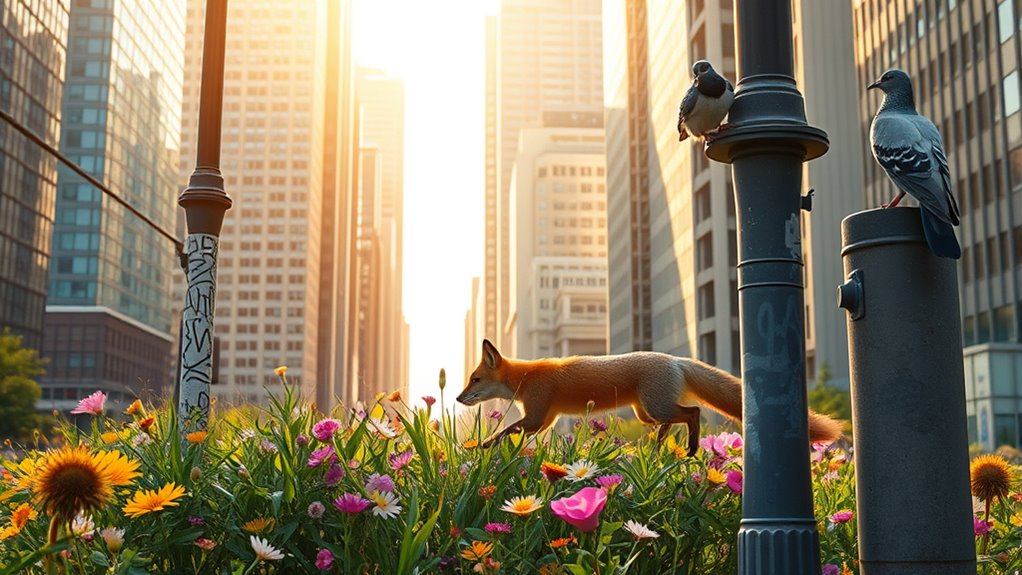
Urban wildlife plays a significant role in shaping ecosystems, often in unexpected ways. As urban areas expand, they lead to habitat loss and fragmentation, which affects species diversity.
You might notice that urban environments favor generalist species, resulting in biotic homogenization. This shift displaces many native species, pushing them into parks or forest fragments.
Urbanization also alters predator-prey dynamics, disrupting ecosystem balance. With abundant food resources available, certain species thrive, while others face increased predation pressure due to mesopredator release. This phenomenon is often exacerbated by the loss of top predators, which can lead to a rise in smaller predator populations that further disrupt the ecosystem.
Additionally, human-wildlife conflict can arise from reduced fear among animals, increasing safety risks for everyone.
Understanding these impacts helps you appreciate the complexity of urban ecosystems and the need for sustainable planning to support biodiversity.
The Future of Urban Wildlife: Trends and Solutions
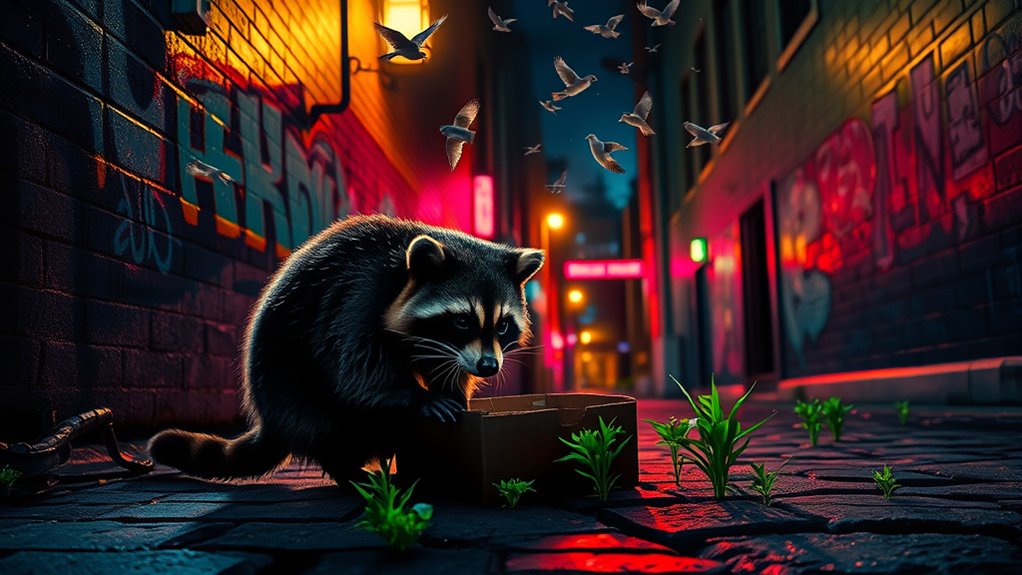
As urban areas continue to grow, you'll need to take into account how sustainable urban planning can shape the future of wildlife. By integrating wildlife adaptation strategies into city designs, you can create spaces that support both human life and diverse ecosystems. Embracing these solutions now will help guarantee a balanced coexistence in our increasingly urbanized world. Furthermore, implementing effective waste management can significantly reduce food waste, which is crucial for preventing obesity and health issues in urban wildlife. Additionally, promoting sustainable practices in urban agriculture can enhance biodiversity and support local wildlife habitats.
Sustainable Urban Planning
Sustainable urban planning is essential for fostering a harmonious coexistence between human populations and wildlife in rapidly growing cities.
By implementing effective strategies, you can help create environments where both thrive. Here are three key approaches:
- Integrated Urban Planning: Incorporate wildlife needs into city designs, ensuring habitats are preserved amidst development.
- Green Infrastructure: Establish parks, green corridors, and native landscaping to enhance biodiversity and provide crucial connections for wildlife.
- Community Engagement: Involve residents in conservation efforts, raising awareness and encouraging participation in local wildlife initiatives.
Wildlife Adaptation Strategies
Cities are evolving rapidly, and with this growth comes the challenge of wildlife adaptation. Urban wildlife, like raccoons and coyotes, often thrive in these environments, finding food and shelter in human spaces. To survive, they adapt their diets to include scavenging, and many species evolve to have smaller body sizes, making navigation easier in crowded areas. Behavioral changes also occur, with altered foraging patterns and reduced mobility. However, habitat loss pushes wildlife closer to humans, increasing conflicts. To foster coexistence, strategies like native planting and creating wildlife corridors can help, as urban wildlife increasingly utilizes small natural areas for sustenance and shelter.
Frequently Asked Questions
How Do Urban Wildlife Species Communicate With Each Other?
Urban wildlife species communicate using various methods.
You'll notice they rely on visual signals, like posturing and bright colors, to attract mates or warn others.
Vocalizations play a big role too; birds and mammals use unique sounds for mating and territory marking.
Scent marking helps convey identity and reproductive status.
Additionally, many species adapt their behaviors to thrive in urban settings, ensuring they effectively interact and coexist with one another amidst human activity.
What Role Do Urban Gardens Play in Supporting Wildlife?
Urban gardens are like tiny oases in a bustling desert, supporting wildlife in remarkable ways.
They provide essential habitats, food sources, and shelter for various species. By planting diverse flowers and creating features like log piles and ponds, you attract pollinators and small mammals.
These gardens also enhance local biodiversity and can act as corridors for wildlife, making your green space a vital part of the urban ecosystem.
Embrace gardening for nature's sake!
How Do Urban Wildlife Populations Compare to Rural Populations?
When you compare urban wildlife populations to rural ones, you'll notice distinct differences.
Urban areas often host a mix of native and invasive species that adapt to human presence, while rural regions typically support more diverse ecosystems.
In cities, animals may become more reliant on human food sources and exhibit different behaviors.
However, rural habitats often provide a richer variety of natural resources, fostering greater biodiversity among wildlife populations.
Can Urban Wildlife Be Trained or Domesticated?
You can't really train or domesticate urban wildlife effectively. These animals, like raccoons and coyotes, thrive in cities without human intervention, retaining their wild instincts.
Efforts to manage human-wildlife conflict focus on deterrents rather than training. Plus, ethical concerns arise with domestication, potentially disrupting ecosystems and harming animal welfare.
Instead, fostering coexistence and preserving habitats should be your priority for ensuring a balanced environment for both wildlife and humans.
What Are Common Misconceptions About Urban Wildlife?
You might think urban wildlife are just pests or that they harm ecosystems, but that's a misconception. Many species play crucial roles, like controlling pests and pollinating plants.
You might believe urban areas lack natural habitats, yet parks and green spaces offer refuge for diverse species. Plus, with proper planning, humans and wildlife can coexist peacefully.
Urban conservation efforts are essential, and they can be highly effective when communities engage in protecting local biodiversity.
Conclusion
As you explore the secret lives of urban wildlife, you'll realize these creatures adapt in remarkable ways. Imagine a family of raccoons maneuvering through your neighborhood, using fences like tightropes to reach their next meal. Despite the challenges they face, from habitat loss to pollution, these animals thrive alongside us, reminding us of nature's resilience. By fostering urban ecosystems and embracing innovative solutions, we can guarantee a harmonious coexistence, allowing both wildlife and humans to flourish together.
